Bing Yu
Breast Cancer Classification in Deep Ultraviolet Fluorescence Images Using a Patch-Level Vision Transformer Framework
May 12, 2025Abstract:Breast-conserving surgery (BCS) aims to completely remove malignant lesions while maximizing healthy tissue preservation. Intraoperative margin assessment is essential to achieve a balance between thorough cancer resection and tissue conservation. A deep ultraviolet fluorescence scanning microscope (DUV-FSM) enables rapid acquisition of whole surface images (WSIs) for excised tissue, providing contrast between malignant and normal tissues. However, breast cancer classification with DUV WSIs is challenged by high resolutions and complex histopathological features. This study introduces a DUV WSI classification framework using a patch-level vision transformer (ViT) model, capturing local and global features. Grad-CAM++ saliency weighting highlights relevant spatial regions, enhances result interpretability, and improves diagnostic accuracy for benign and malignant tissue classification. A comprehensive 5-fold cross-validation demonstrates the proposed approach significantly outperforms conventional deep learning methods, achieving a classification accuracy of 98.33%.
SRPO: A Cross-Domain Implementation of Large-Scale Reinforcement Learning on LLM
Apr 22, 2025Abstract:Recent advances of reasoning models, exemplified by OpenAI's o1 and DeepSeek's R1, highlight the significant potential of Reinforcement Learning (RL) to enhance the reasoning capabilities of Large Language Models (LLMs). However, replicating these advancements across diverse domains remains challenging due to limited methodological transparency. In this work, we present two-Staged history-Resampling Policy Optimization (SRPO), which surpasses the performance of DeepSeek-R1-Zero-32B on the AIME24 and LiveCodeBench benchmarks. SRPO achieves this using the same base model as DeepSeek (i.e. Qwen2.5-32B), using only about 1/10 of the training steps required by DeepSeek-R1-Zero-32B, demonstrating superior efficiency. Building upon Group Relative Policy Optimization (GRPO), we introduce two key methodological innovations: (1) a two-stage cross-domain training paradigm designed to balance the development of mathematical reasoning and coding proficiency, and (2) History Resampling (HR), a technique to address ineffective samples. Our comprehensive experiments validate the effectiveness of our approach, offering valuable insights into scaling LLM reasoning capabilities across diverse tasks.
Physics-informed DeepCT: Sinogram Wavelet Decomposition Meets Masked Diffusion
Jan 17, 2025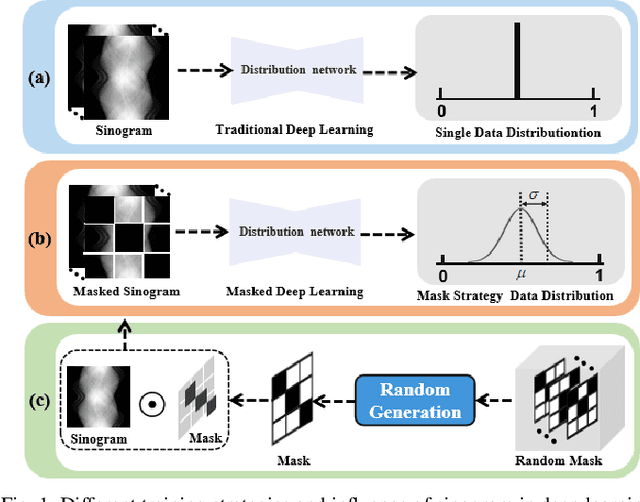
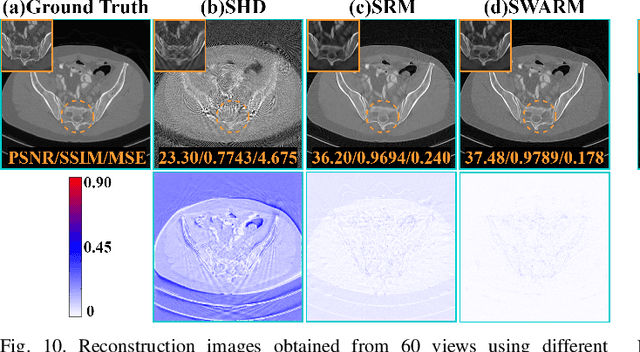
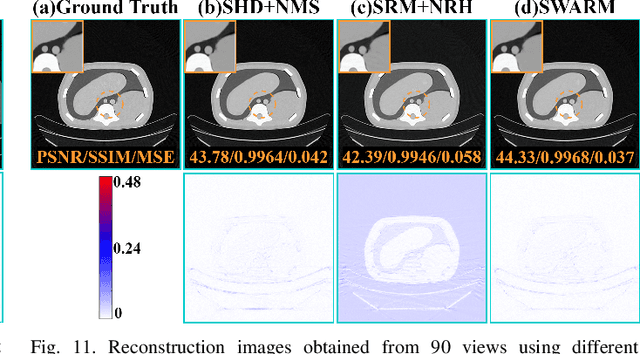
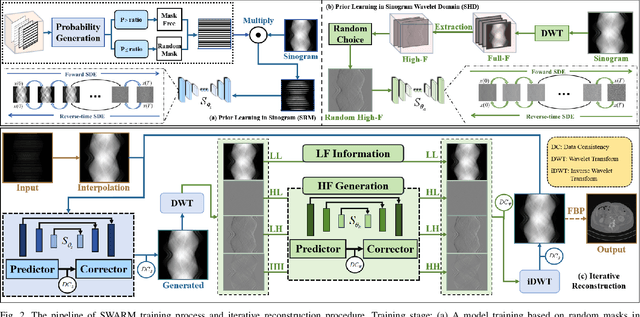
Abstract:Diffusion model shows remarkable potential on sparse-view computed tomography (SVCT) reconstruction. However, when a network is trained on a limited sample space, its generalization capability may be constrained, which degrades performance on unfamiliar data. For image generation tasks, this can lead to issues such as blurry details and inconsistencies between regions. To alleviate this problem, we propose a Sinogram-based Wavelet random decomposition And Random mask diffusion Model (SWARM) for SVCT reconstruction. Specifically, introducing a random mask strategy in the sinogram effectively expands the limited training sample space. This enables the model to learn a broader range of data distributions, enhancing its understanding and generalization of data uncertainty. In addition, applying a random training strategy to the high-frequency components of the sinogram wavelet enhances feature representation and improves the ability to capture details in different frequency bands, thereby improving performance and robustness. Two-stage iterative reconstruction method is adopted to ensure the global consistency of the reconstructed image while refining its details. Experimental results demonstrate that SWARM outperforms competing approaches in both quantitative and qualitative performance across various datasets.
Deep learning for automated detection of breast cancer in deep ultraviolet fluorescence images with diffusion probabilistic model
Jul 01, 2024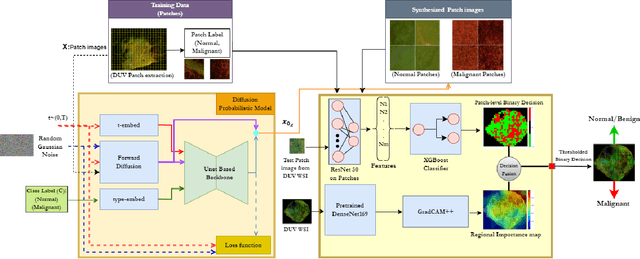


Abstract:Data limitation is a significant challenge in applying deep learning to medical images. Recently, the diffusion probabilistic model (DPM) has shown the potential to generate high-quality images by converting Gaussian random noise into realistic images. In this paper, we apply the DPM to augment the deep ultraviolet fluorescence (DUV) image dataset with an aim to improve breast cancer classification for intraoperative margin assessment. For classification, we divide the whole surface DUV image into small patches and extract convolutional features for each patch by utilizing the pre-trained ResNet. Then, we feed them into an XGBoost classifier for patch-level decisions and then fuse them with a regional importance map computed by Grad-CAM++ for whole surface-level prediction. Our experimental results show that augmenting the training dataset with the DPM significantly improves breast cancer detection performance in DUV images, increasing accuracy from 93% to 97%, compared to using Affine transformations and ProGAN.
KS-Net: Multi-band joint speech restoration and enhancement network for 2024 ICASSP SSI Challenge
Feb 02, 2024

Abstract:This paper presents the speech restoration and enhancement system created by the 1024K team for the ICASSP 2024 Speech Signal Improvement (SSI) Challenge. Our system consists of a generative adversarial network (GAN) in complex-domain for speech restoration and a fine-grained multi-band fusion module for speech enhancement. In the blind test set of SSI, the proposed system achieves an overall mean opinion score (MOS) of 3.49 based on ITU-T P.804 and a Word Accuracy Rate (WAcc) of 0.78 for the real-time track, as well as an overall P.804 MOS of 3.43 and a WAcc of 0.78 for the non-real-time track, ranking 1st in both tracks.
BAE-Net: A Low complexity and high fidelity Bandwidth-Adaptive neural network for speech super-resolution
Dec 21, 2023



Abstract:Speech bandwidth extension (BWE) has demonstrated promising performance in enhancing the perceptual speech quality in real communication systems. Most existing BWE researches primarily focus on fixed upsampling ratios, disregarding the fact that the effective bandwidth of captured audio may fluctuate frequently due to various capturing devices and transmission conditions. In this paper, we propose a novel streaming adaptive bandwidth extension solution dubbed BAE-Net, which is suitable to handle the low-resolution speech with unknown and varying effective bandwidth. To address the challenges of recovering both the high-frequency magnitude and phase speech content blindly, we devise a dual-stream architecture that incorporates the magnitude inpainting and phase refinement. For potential applications on edge devices, this paper also introduces BAE-NET-lite, which is a lightweight, streaming and efficient framework. Quantitative results demonstrate the superiority of BAE-Net in terms of both performance and computational efficiency when compared with existing state-of-the-art BWE methods.
Multi-scale temporal-frequency attention for music source separation
Sep 02, 2022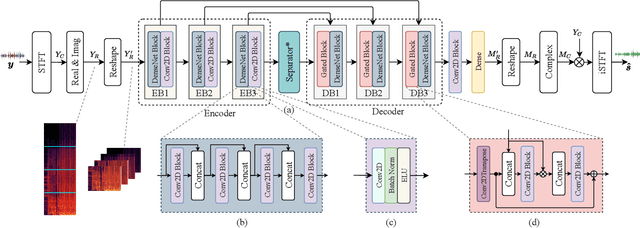
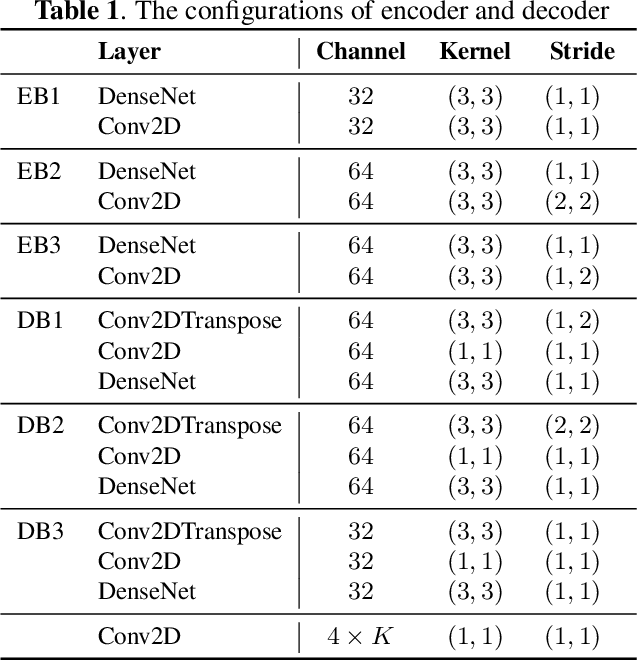

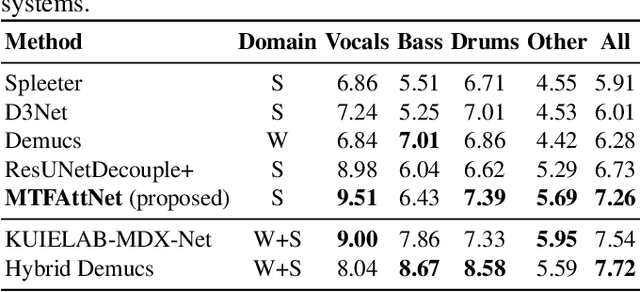
Abstract:In recent years, deep neural networks (DNNs) based approaches have achieved the start-of-the-art performance for music source separation (MSS). Although previous methods have addressed the large receptive field modeling using various methods, the temporal and frequency correlations of the music spectrogram with repeated patterns have not been explicitly explored for the MSS task. In this paper, a temporal-frequency attention module is proposed to model the spectrogram correlations along both temporal and frequency dimensions. Moreover, a multi-scale attention is proposed to effectively capture the correlations for music signal. The experimental results on MUSDB18 dataset show that the proposed method outperforms the existing state-of-the-art systems with 9.51 dB signal-to-distortion ratio (SDR) on separating the vocal stems, which is the primary practical application of MSS.
A two-step backward compatible fullband speech enhancement system
Jan 28, 2022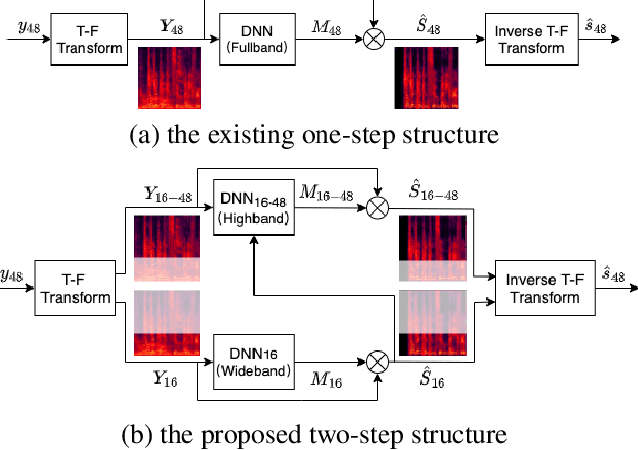
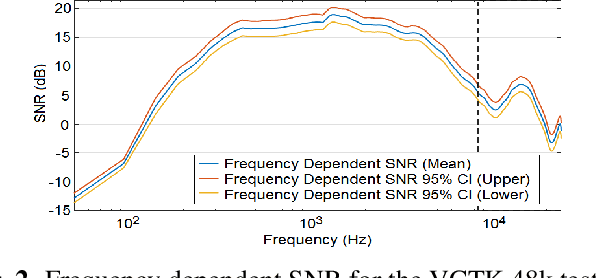
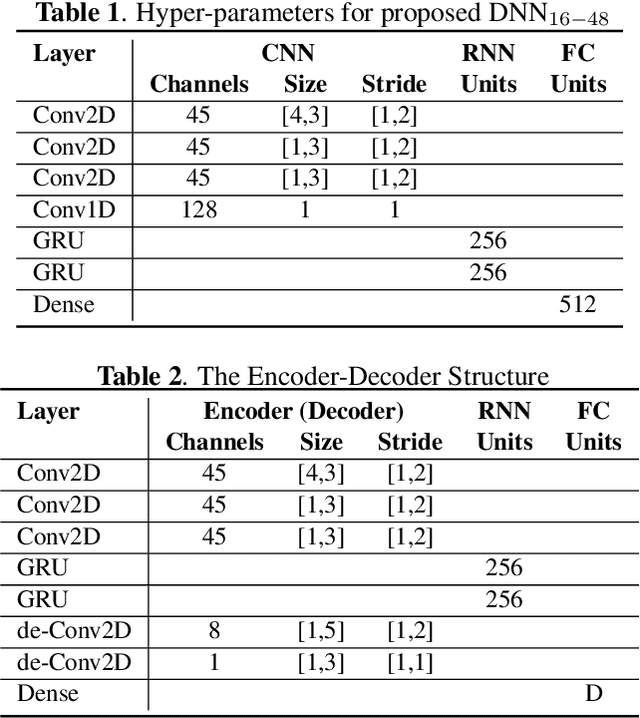
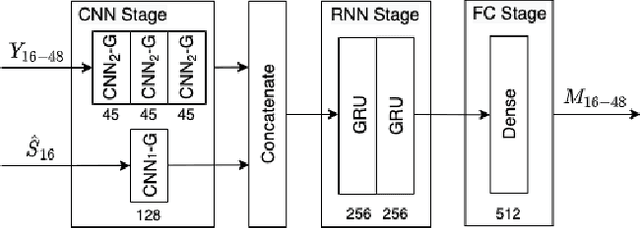
Abstract:Speech enhancement methods based on deep learning have surpassed traditional methods. While many of these new approaches are operating on the wideband (16kHz) sample rate, a new fullband (48kHz) speech enhancement system is proposed in this paper. Compared to the existing fullband systems that utilizes perceptually motivated features to train the fullband speech enhancement using a single network structure, the proposed system is a two-step system ensuring good fullband speech enhancement quality while backward compatible to the existing wideband systems.
DeepRepair: Style-Guided Repairing for DNNs in the Real-world Operational Environment
Nov 19, 2020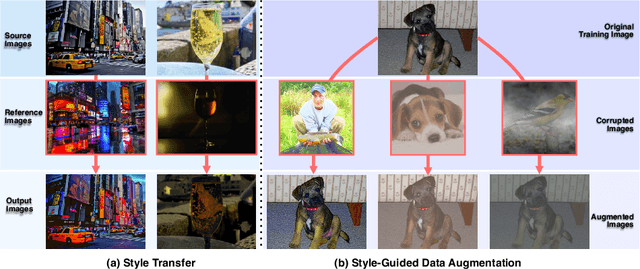
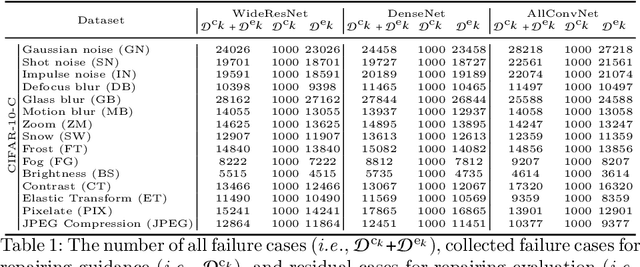
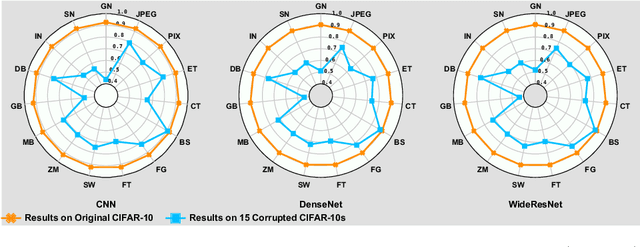
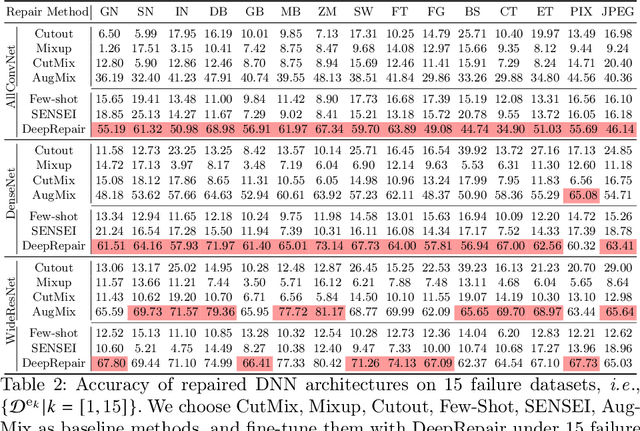
Abstract:Deep neural networks (DNNs) are being widely applied for various real-world applications across domains due to their high performance (e.g., high accuracy on image classification). Nevertheless, a well-trained DNN after deployment could oftentimes raise errors during practical use in the operational environment due to the mismatching between distributions of the training dataset and the potential unknown noise factors in the operational environment, e.g., weather, blur, noise etc. Hence, it poses a rather important problem for the DNNs' real-world applications: how to repair the deployed DNNs for correcting the failure samples (i.e., incorrect prediction) under the deployed operational environment while not harming their capability of handling normal or clean data. The number of failure samples we can collect in practice, caused by the noise factors in the operational environment, is often limited. Therefore, It is rather challenging how to repair more similar failures based on the limited failure samples we can collect. In this paper, we propose a style-guided data augmentation for repairing DNN in the operational environment. We propose a style transfer method to learn and introduce the unknown failure patterns within the failure data into the training data via data augmentation. Moreover, we further propose the clustering-based failure data generation for much more effective style-guided data augmentation. We conduct a large-scale evaluation with fifteen degradation factors that may happen in the real world and compare with four state-of-the-art data augmentation methods and two DNN repairing methods, demonstrating that our method can significantly enhance the deployed DNNs on the corrupted data in the operational environment, and with even better accuracy on clean datasets.
Classify and Generate Reciprocally: Simultaneous Positive-Unlabelled Learning and Conditional Generation with Extra Data
Jun 14, 2020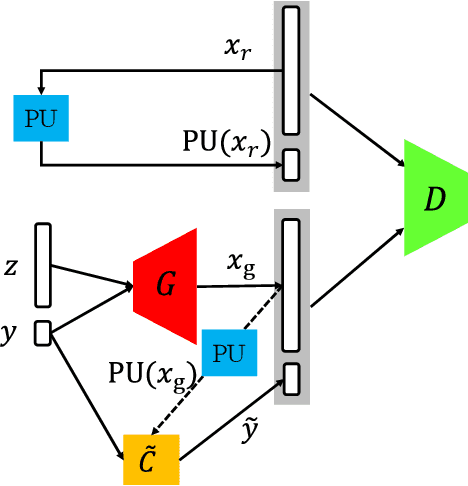
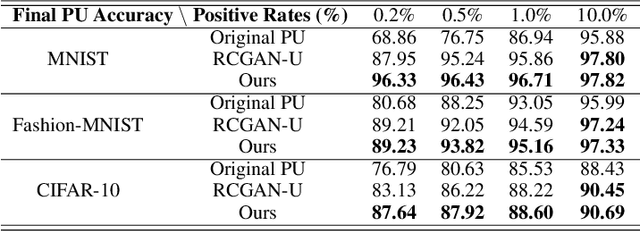
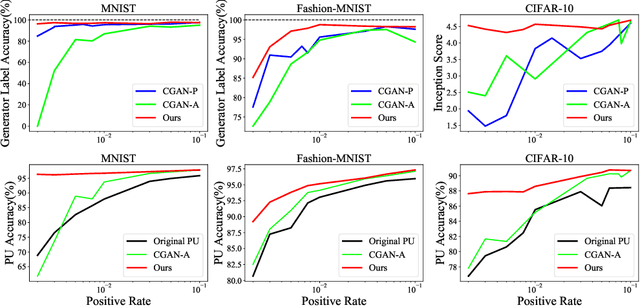

Abstract:The scarcity of class-labeled data is a ubiquitous bottleneck in a wide range of machine learning problems. While abundant unlabeled data normally exist and provide a potential solution, it is extremely challenging to exploit them. In this paper, we address this problem by leveraging Positive-Unlabeled~(PU) classification and conditional generation with extra unlabeled data \emph{simultaneously}, both of which aim to make full use of agnostic unlabeled data to improve classification and generation performances. In particular, we present a novel training framework to jointly target both PU classification and conditional generation when exposing to extra data, especially out-of-distribution unlabeled data, by exploring the interplay between them: 1) enhancing the performance of PU classifiers with the assistance of a novel Conditional Generative Adversarial Network~(CGAN) that is robust to noisy labels, 2) leveraging extra data with predicted labels from a PU classifier to help the generation. Our key contribution is a Classifier-Noise-Invariant Conditional GAN~(CNI-CGAN) that can learn the clean data distribution from noisy labels predicted by a PU classifier. Theoretically, we proved the optimal condition of CNI-CGAN and experimentally, we conducted extensive evaluations on diverse datasets, verifying the simultaneous improvements on both classification and generation.
 Add to Chrome
Add to Chrome Add to Firefox
Add to Firefox Add to Edge
Add to Edge